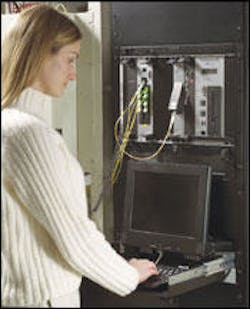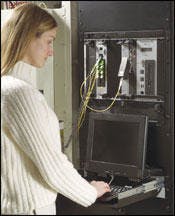New metro monitoring system promises peace of mind
BY MEGHAN FULLER
When the folks at Nettest (Utica, NY) developed their new monitoring device for the metro network, they had a specific application and end user in mind. Because metro service providers must maintain and support a large number of services while guaranteeing a certain quality of service at minimum cost, they need a device that will give them visibility into the status of their fiber. Enter metroWATCH, a standalone fiber-monitoring tool that has already captured the attention of two RBOCs."To be honest," admits David Coker, vice president of marketing for Nettest's optical-network systems division, "we didn't expect the RBOCs to be as interested as they are; that was a surprise. It was not obvious to us that this would fit within their [needs], but they have a whole bunch of services where this fits perfectly." With the Nettest box generating so much attention, it may not be long before others in the optical test and measurement equipment industry follow suit.
The Nettest metroWATCH monitoring tool is geared specifically for non-fiber experts-in places like airports or in emergency service situations and even within a carrier's organization. While most metro carriers have SONET, ATM, and possibly IP or frame relay technicians on staff, few have a full-time optical layer specialist, contends Coker. "It's kind of a dilemma," he says. "They need the fiber to deliver services, but most have a copper-based background."
With metroWATCH, say the folks at Nettest, you don't need a full-time fiber expert. The device provides automatic notification of fiber faults-and it will contact your contractor automatically. It also provides network administrators with up-to-date information on the status of their infrastructure and enables them to focus on other parts of the network by eliminating the optical layer as a possible problem.
"The biggest challenge is if I'm offering all these different layers of services, and I have all this complexity, where do I begin to look for problems?" asks Coker. The best way to begin looking for network problems is to eliminate possible causes, and the Nettest box does just that, he says. If an operator is experiencing a number of IP problems, but metroWATCH has not issued a fiber alarm, the operator can focus on other aspects of the network.
"It's really like a smoke alarm for your fiber," asserts Coker. "You mount it on your wall, put the battery in, push the button to test it to make sure it's operating, and then you don't think about it again."
As an option, the metroWATCH box can also track fiber and optical quality of service (QoS). It will automatically print a report to document service on a per-customer basis-which is a critical functionality, claims Nettest. To have someone sift through records by hand, look through field calls, and attempt to identify problems is both time-consuming and costly.
The metroWATCH box features multiple testing modules; it does optical time-domain reflectometer (OTDR) monitoring on four fibers at a time, optical spectrum analysis, and power monitoring. The box also includes optical switches, which enable multiple fiber testing simultaneously; a single unit can monitor up to 24 fibers.
"If you look at some of the larger metro carriers with the big cables, [metroWATCH] doesn't do every fiber in the cable, but it does 24, which would be representative," explains Coker. "Or it could be used to monitor key customers."
The box itself is housed in an industry-standard chassis, is rackmountable to fit into an IT or telecommunications environment, and can be configured for either AC or DC power. Pricing for metroWATCH begins at $50,000.
"I don't know that $50,000 is the price point that will drive service providers wild, but I suspect it's probably pretty close," contends Richard Cunningham, senior analyst for optical networking at Cahners In-Stat Group (Scottsdale, AZ). "At $50,000, you can monitor four fibers for a year; that's roughly $1,000 per month per fiber-which is something on the order of 30-40% cheaper than a manned unit."
Service providers have already begun to take note. Nettest has a purchase order from one RBOC, and the metroWATCH has been approved by another, so regional providers within the RBOC can purchase it. "The interesting dilemma for the RBOC [that has purchased the metroWATCH product] is they put in fiber for this customer and operate the service, but they have no visibility as to the status because it's sort of a self-contained network," explains Coker.
The RBOC is using metroWATCH to monitor this customer's service from their own operations center; they can centrally assess the quality of the fiber without deploying people to the field, which saves both time and money, says Coker. In the future, Nettest plans to incorporate SONET transport checking, but it is not part of this year's roadmap.
When asked why the metroWATCH box has already caught the attention of the RBOC community, Cunningham asserts that "it seems like a logical extension of where the OTDR ought to go. I wouldn't be surprised if the other usual suspects aren't working on the same thing themselves." At least two of Nettest's competitors are, in fact, ready to publicly announce a metro-monitoring product, while several others say they have something similar in the works.
At press time, EXFO (Quebec) was planning to unveil its new Remote Test Unit at OFC 2002 in March. Like the metroWATCH box, the EXFO device will feature continuous OTDR monitoring, optical-spectrum-analyzer (OSA) compatibility, and automatic alarm notification to a pager, digital cell phone, or e-mail address.
Meanwhile, Acterna (Germantown, MD) offers a standalone metro-monitoring tool designed for non-fiber experts. Like its competition, the Acterna device also features automatic fault notification, OTDR, and OSA functionality as well as optical switches for monitoring multiple fibers simultaneously.

